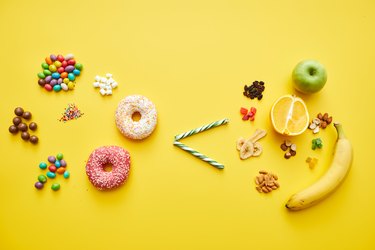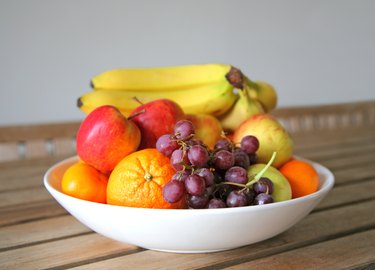
For the longest time — at least on food products' nutrition facts label — natural and added sugars were lumped together as one and the same. But as of January 2020, this is no longer the case.
The Food and Drug Administration's (FDA) new nutrition label now requires that food manufactures specify the amount of added sugars found in a serving of any packaged food, and for good reason.
Video of the Day
Video of the Day
Added sugars have been linked to heart disease and type 2 diabetes, as explained by the American Heart Association (AHA). In fact, differentiating between added sugars and natural sugars — just on food labels alone — could prevent nearly a million cases of type 2 diabetes and heart disease and save billions in health care costs in the U.S., according to an April 2019 study published in Circulation.
But it might not be that clear cut, especially when it comes to the quality of natural sugars.
So why is it so important to differentiate between natural sugars and added sugars and how to the two types differ? Let's take a closer look.
What Is Added Sugar?

Added sugars are just that — they're added into a food product during the manufacturing process, so they aren't naturally occurring in the food. In many cases, they're added for their sweet flavor but the sugars can play other roles like adding bulk or giving the food the right texture.
The FDA's definition of added sugar specifies that it's "sugar added during the processing of foods, or are packaged as such (like a bag of sugar); it includes sugars from syrups and honey; as well as sugars from concentrated fruit or vegetable juices that are in excess of what would be expected from the same volume of 100-percent fruit or vegetable juice of the same type."
Food manufacturers incorporate added sugar to 74 percent of packaged foods and added sugar can be found under 61 different names, according to the University of California, San Francisco
You can spot added sugars on ingredient lists by looking for these words: raw sugar, brown sugar, fruit juice concentrates, glucose, molasses, honey, high-fructose corn syrup, fructose, invert sugar and corn sweetener, among others.
The Negative Effects of Added Sugars
What's important to note is that added sugars aren't essential to our diet and, in fact, they can be harmful if we eat too much. And it turns out we do.
The current recommendations set by the AHA are that women should consume no more than 100 calories or six teaspoons (25 grams) of added sugar per day and men, no more than 150 calories or nine teaspoons (36 grams). On average, American adults get 17 teaspoons of added sugar each day (!), according to the 2015-2020 Dietary Guidelines for Americans.
The University of California, San Francisco has been doing a lot of research on added sugars and found that eating more added sugars than what's recommended on a daily basis can have serious health implications.
Eating so much sugar can leave us craving more, stimulating our appetites and increasing our insulin levels — all of which can lead to weight gain. Added sugars can also play a role in heart disease, as mentioned by the AHA.
What Is Natural Sugar?

The two big food groups with natural sugars — aka, sugars found naturally in foods — are fruits and dairy. Fruits contain a naturally occurring sugar called fructose while some dairy (such as milk and yogurt) contain a naturally occurring sugar called lactose.
Sources of natural sugar typically come from nutritious foods that contain a variety of other nutrients. For example, an orange provides fiber and vitamins and A and C, while a cup of yogurt offers protein, probiotics and calcium. But the source of the natural sugar and how they're processed matters.
Not All Natural Sugars Are Created Equal
Whether you want to eat a piece of unsweetened dried apple slices, a fresh apple or a glass of 100-percent apple juice, all are considered to contain natural sugar. But the way these various foods are processed, or in the case of the fresh apple, unprocessed, matters because it alters factors including the fiber content and the volume of the food.
It might take six apples to create a glass of apple juice, and you'll get all of those grams of natural sugars but none of the fiber that you'd find in a piece of fresh fruit. This can cause a spike in your blood sugar levels and you'll miss out on the benefits of the soluble fiber.
And because dried fruit requires removing the majority of the water from the fruit, it concentrates all the sugar in a smaller piece of fruit. What's more, you're left with a small piece of fruit that can be eaten in a bite or two versus the number of bites you'd take to eat an entire apple, which may make you feel less satiated.
How to Avoid Added Sugars
The easiest way to avoid added sugars is to limit the foods commonly made with added sugars. These include:
- Regular, non-diet soda
- Baked goods
- Candies
- Sweet sauces (such as barbecue sauce and ketchup)
- Low-fat foods
- Some ready-made meals (read the labels)
It's also very important to read the ingredients list on food packaging. Remember, an estimated 74 percent of packaged foods contain added sugar, and added sugar can be found under 61 different names.
Related Reading
- American Heart Association: "Study: Massive Health Gains from New Food Labels with Sugar Details"
- Circulation: "Cost-Effectiveness of the US Food and Drug Administration Added Sugar Labeling Policy for Improving Diet and Health"
- Food and Drug Administration: "Food Labeling: Revision of the Nutrition and Supplement Facts Labels"
- American Heart Association: "Added Sugars"
- 2015-2020 Dietary Guidelines for Americans: "Cut Down on Added Sugars"
- The University of California San Francisco: "How Much Is Too Much?"
- The University of California San Francisco: "Hidden In Plain Sight"